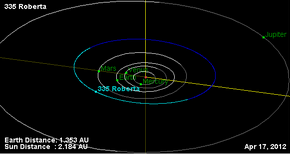 Orbital diagram Orbital diagram | |
| Discovery | |
|---|---|
| Discovered by | Anton Staus |
| Discovery date | 1 September 1892 |
| Designations | |
| MPC designation | (335) Roberta |
| Named after | Carl Robert Osten-Sacken |
| Alternative designations | 1892 C |
| Minor planet category | Main belt |
| Orbital characteristics | |
| Epoch 31 July 2016 (JD 2457600.5) | |
| Uncertainty parameter 0 | |
| Observation arc | 123.58 yr (45137 d) |
| Aphelion | 2.9014 AU (434.04 Gm) |
| Perihelion | 2.04926 AU (306.565 Gm) |
| Semi-major axis | 2.47530 AU (370.300 Gm) |
| Eccentricity | 0.17212 |
| Orbital period (sidereal) | 3.89 yr (1422.5 d) |
| Average orbital speed | 18.93 km/s |
| Mean anomaly | 355.460° |
| Mean motion | 0° 15 11.095 / day |
| Inclination | 5.1005° |
| Longitude of ascending node | 148.454° |
| Argument of perihelion | 140.006° |
| Earth MOID | 1.03587 AU (154.964 Gm) |
| Jupiter MOID | 2.2733 AU (340.08 Gm) |
| TJupiter | 3.456 |
| Physical characteristics | |
| Dimensions | 89.07±2.0 km |
| Synodic rotation period | 12.054 h (0.5023 d) |
| Geometric albedo | 0.0580±0.003 0.058 |
| Spectral type | B–V = 0.624 U–B = 0.235 FP (Tholen) B (SMASS) |
| Absolute magnitude (H) | 8.96 |
335 Roberta is a large main belt asteroid. It was discovered on 1 September 1892, by German astronomer Anton Staus at Heidelberg Observatory. Roberta was the 12th asteroid that was discovered using photography, and the only asteroid discovery made by Staus.
Photometric observations of this asteroid from multiple sites during 2007 gave a light curve with a period of 12.054 ± 0.003 hours and a brightness variation of 0.13 ± 0.02 in magnitude. This agrees with a result reported in 1992, but differs from period estimates of 8.03 hours and 4.349 reported in 1987 and 2001, respectively.
Under the SMASS classification taxonomy, this asteroid is listed as a B-type; a group that combines both the Tholen B and F types. The spectrum of this object suggests the presence of magnetite (Fe3O4), which gives it the spectrally-blue coloration that is a characteristic of this SMASS class. The spectrum of this asteroid also displays a band feature near 2.9 μm that indicate the presence of a hydrated mineral. This suggests that the asteroid has undergone significant water-based alteration.
335 Roberta was identified as one of three asteroids that were likely to be a parent body for chondrites along with 449 Hamburga and 304 Olga. All three asteroids were known to have low-albedo (not reflect as much light) and be close to "meteorite producing resonances". Chrondrites are the most common type of meteor found on Earth, accounting for over 80% of all meteors. They are named for the tiny spherical silicate particles that are found inside them (those particles are called chondrules).
References
- ^ "335 Roberta", JPL Small-Body Database Browser, NASA Jet Propulsion Laboratory, retrieved 11 May 2016
- ^ Yang, Bin; Jewitt, David (September 2010), "Identification of Magnetite in B-type Asteroids", The Astronomical Journal, 140 (3): 692–698, arXiv:1006.5110, Bibcode:2010AJ....140..692Y, doi:10.1088/0004-6256/140/3/692
- "Numbered Minor Planets 1–5000", Discovery Circumstances, IAU Minor Planet center, retrieved 7 April 2013.
- Kutter, A. (December 1957). "Nachruf auf Anton Staus (Obituary)". Mitteilungen der Astronomischen Gesellschaft (in German). 9: 5. Bibcode:1958MitAG...9....5K. Retrieved 6 July 2016.
- Warner, Brian D.; et al. (December 2007), "Lightcurve Analysis of 335 Roberta", The Minor Planet Bulletin, vol. 34, no. 4, p. 99, Bibcode:2007MPBu...34...99W.
- ^ Lunar and planetary science: abstracts of papers submitted to the ... Lunar and Planetary Science Conference, Volume 27, Part 1 - Lunar and Planetary Institute, Jan 1, 1996
- ^ "ASU - Chondrites". Archived from the original on 22 June 2019. Retrieved 31 August 2015.
External links
- Lightcurve plot of 335 Roberta, Palmer Divide Observatory, B. D. Warner (2007)
- Asteroid Lightcurve Database (LCDB), query form (info Archived 16 December 2017 at the Wayback Machine)
- Dictionary of Minor Planet Names, Google books
- Asteroids and comets rotation curves, CdR – Observatoire de Genève, Raoul Behrend
- Discovery Circumstances: Numbered Minor Planets (1)-(5000) – Minor Planet Center
- 335 Roberta at AstDyS-2, Asteroids—Dynamic Site
- 335 Roberta at the JPL Small-Body Database

| Minor planets navigator | |
|---|---|
| Small Solar System bodies | |||||||
|---|---|---|---|---|---|---|---|
| Minor planets |
| ||||||
| Comets | |||||||
| Other | |||||||